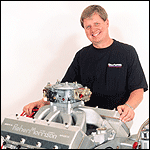 By David Reher, Reher-Morrison Racing Engines
By David Reher, Reher-Morrison Racing Engines
“A dry-sump oil system is one of the few products you can buy with confidence that it will improve performance.”
According to the informal David Reher telephone poll, interest in fast Sportsman classes is skyrocketing. If the sample of racers I talk to is representative of the sport as a whole, then Top Sportsman racing has a bright future. Interest in this particular style of fast doorslammer racing is spreading as quickly as a rumor on the Internet. The fact that Top Sportsman has been adopted by several NHRA divisions is a leading indicator of the class’ future growth.
As participation in fast classes such as Top Sportsman, Top Dragster and Quick 32 shows accelerates, a powerful, big-inch engine is no longer a luxury – it’s a necessity. When racers upgrade their engines to meet the need for quicker elapsed times, I find myself talking more frequently about the advantages of dry-sump lubrication systems for drag racing.
Dry-sump systems aren’t just for Pro Stocks anymore. Just as induction and camshaft technology has migrated from the Pro pits to the Sportsman staging lanes, Pro-style lubrication systems science has also made the leap to Sportsman engines. I certainly don’t suggest that every Sportsman racer with a 509 or 522-cubic-inch big-block immediately invest in a dry-sump pump and hardware – but if you are building a 565 or larger engine and turning it 8,000 rpm or higher, I strongly recommend that you consider a dry-sump system.
In my view, a dry-sump system has four advantages over a wet-sump system: safety, reliability, horsepower and cooling.
Safety is the No. 1 reason to run a dry-sump system in a fast race car. With an external oil tank and an efficient scavenging system, there is very little oil inside the engine that can end up on the track in the aftermath of a catastrophic engine failure. Dry-sunmp oil pans are typically so big and the pan walls are so far away from the rotating assembly that a broken rod seldom penetrates the pan. When you’re running close to 200 mph, the last thing you want is oil under the rear tires.
The dry-sump system I recommend for most Sportsman big-block engines uses a five-stage pump with four sections scavenging the oil pan and one pressure stage. With four oil pan pickups, you can evacuate the pan very efficiently.
Reliability has long been recognized as an advantage of dry-sump oiling. A dry-sump system ensures that an uninterrupted supply of non-aerated oil reaches the bearing. That’s vitally important when you are running a long-stroke engine at high rpm. Even with elaborate windage trays and baffles, a wet-sump system can’t achieve the same level of effectiveness in supplying a constant oil supply as a basic dry-sump system.
A typical Top Sportsman car has a Pro Stock chassis and weighs a minimum of 2,350 pounds. With no limit on engine displacement, these cars accelerate at well over 2 g’s on the starting line and approach 200 mph on the top end. Top Sportsman cars use a parachute for braking, and when the ’chute opens, the negative g’s are high enough to uncover the oil pump pickup in any wet-sump system. Most Top Sportsman cars use automatic transmissions, so the engine gears down during deceleration. It’s essential to maintain constant oil pressure under this condition.
Some racers cite the cost of a dry-sump system as a reason to use a wet-sump, but I don’t think the real price difference is significant. Most high-end wet-sump systems require a belt-driven vacuum pump; that’s money that could be allocated for a dry-sump pump, brackets and pulleys. A dry-sump system is an investment that won’t become obsolete if you build a larger engine next season, and it can save you money in the long run by improving reliability. When you compare the cost of a dry-sump system to the expense of repairing a spun bearing or a broken rod, it’s a bargain.
Installing a dry-sump system reduces the odds of an oil-related failure virtually to zero. About the only possible pitfall is losing a pump belt, and that rarely happens. After all, every NASCAR Winston Cup car in the world runs in circles with a belt-driven oil pump.
A dry-sump system is one of the few racing products you can buy with confidence that it will actually improve performance. If you buy a new carburetor, a new set of headers or a new camshaft, your car’s performance may or may not improve. But if you replace a wet-sump pan with a dry-sump system, you can be confident that horsepower will increase.
An often-overlooked advantage of a dry-sump system is its cooling capacity. The aluminum oil pan and oil tank work like radiators to keep the lubricant cool. That’s important when you’re running with only minutes between rounds in final eliminations.
I wouldn’t race a fast car without a dry-sump oil system, and I urge Sportsman racers to consider the advantages of dry-sump lubrication for drag racing.
